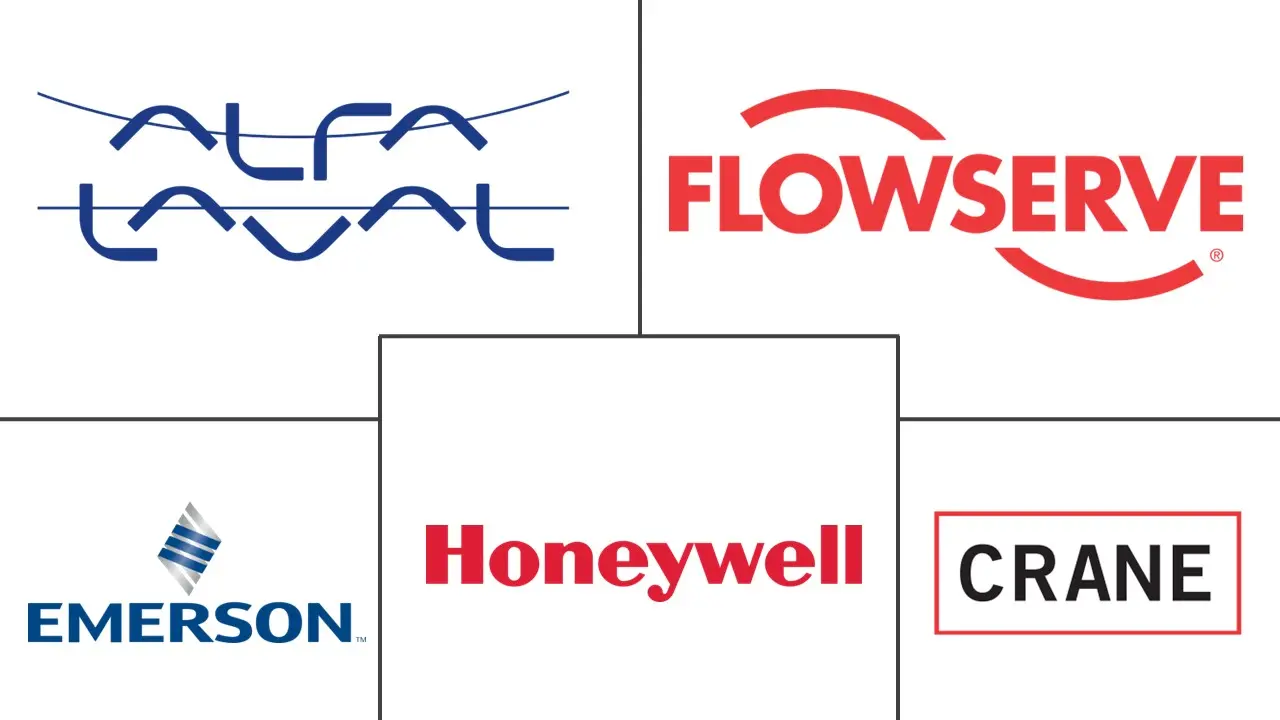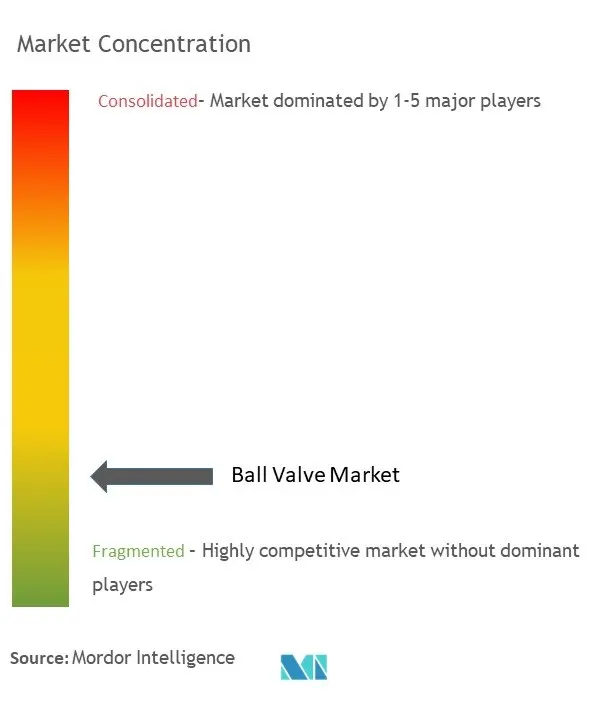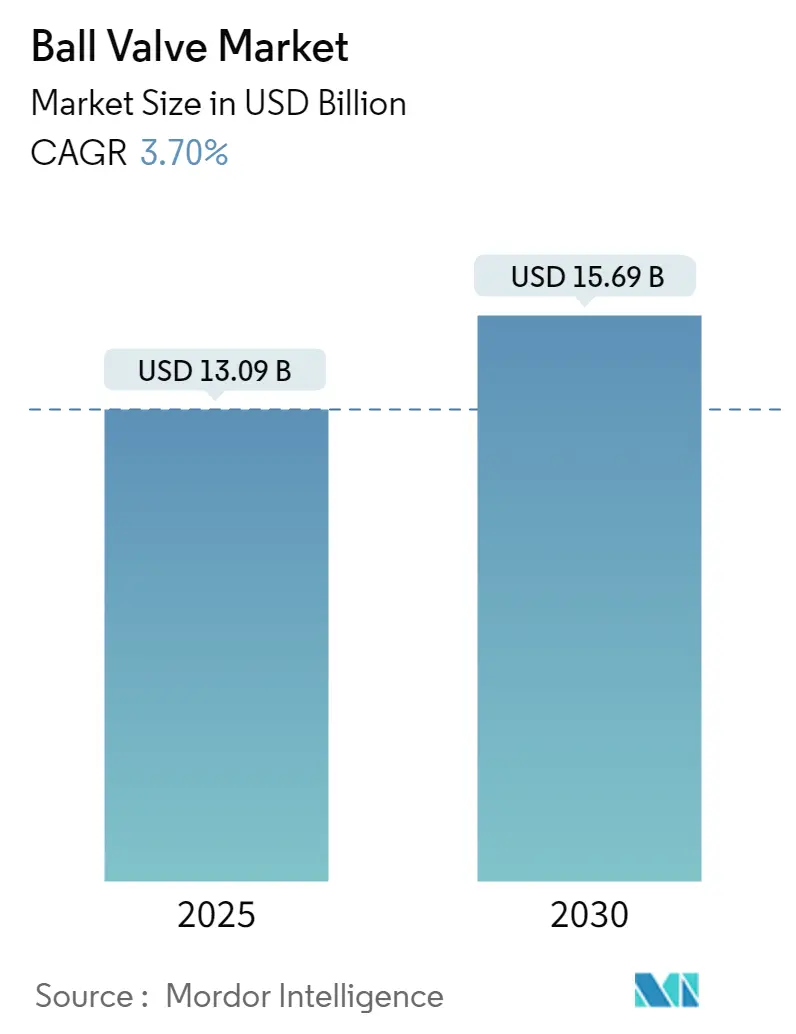
Ball Valve Market Analysis
The Ball Valve Market size is estimated at USD 13.09 billion in 2025, and is expected to reach USD 15.69 billion by 2030, at a CAGR of 3.7% during the forecast period (2025-2030).
A significant rise in the demand for oil and gas is expected to be one of the significant factors contributing to the ball valve market growth. Additionally, rapid industrialization and urbanization are other essential factors supporting the development of the studied market.
- The ball valve is essentially a valve that requires a quarter-turn to operate and is well-suited for clean gas-compressed air and liquid service in industrial applications, owing to its ability to provide a secure shutoff. However, when used for slurry service, measures must be taken to prevent the accumulation of debris. Furthermore, these valves are incredibly robust and highly suitable for applications requiring a simple on/off action. They're also highly durable and maintain consistent performance even after many use cycles.
- Ball valves are the most widely adopted fluid shutoff valves among oil and gas production facilities. These valves are also used in fuel gas systems feeding furnaces. Such applications make the oil-producing regions and regions with huge oil refining capacities attractive targets for the product vendors. Furthermore, as such plants are developed on tender floatation, the market vendors with partnerships and collaborations with such solution providers are expected to have a competitive advantage.
- Among all the types of materials, stainless steel is gaining and is expected to witness importance since they are more corrosion-resistant. Because valves open and close frequently, corrosion can cause significant issues. These valves hold up much better to harsher water types, which can benefit food processing plants. The fact that stainless steel valves also have a higher pressure rating than other materials, such as brass, further drives their adoption.
- Furthermore, the availability of ball valves in different variants, such as unidirectional, bidirectional, or multi-directional, depending on valve ports and the valve seat number, also complements their industrial adoption. These valves are also manufactured based on the classification for high-pressure or low-pressure pipelines, further expanding their use cases. Several vendors are constantly investing in innovative new products, which is acting as one of the major factors driving the market.
- The advancements in valve technology, including the emergence of smart valves and the incorporation of automation and control systems, present fresh prospects in the market. The rising environmental concerns and regulatory mandates fuel the need for eco-friendly and energy-efficient valves. Manufacturers who provide ball valves with minimized emissions, low leakage rates, and enhanced energy efficiency can seize the expanding demand for sustainable solutions.
- Ball valves are commonly employed in larger bore sizes, as alternative valve types like butterfly valves tend to have smaller and weaker stems. In situations where space constraints and structural load are paramount, such as offshore drilling platforms and floating production storage and offloading (FPSOs), users opt for alternatives to ball valves. Furthermore, the limited precision in flow rate control poses a challenge to the growth of the examined market.
Ball Valve Market Trends
Food Processing Industry Expected to Have Significant Applications
- The food processing industry is a notable sector where ball valves find significant application. The process of product fillings necessitates the maintenance of a regulated flow, making ball valves an essential component. The valves employed in the industry are of two types: those that come in direct contact with the material and those used in utility services such as water and steam. In both cases, the valves must comply with several industry regulations, particularly those that come in contact with food material. This presents a considerable challenge for manufacturers to obtain regulatory approvals, requiring them to design valves that meet stringent industry standards.
- Ball valves are highly efficient in controlling and maintaining high volume, temperature, and pressure. In the food and beverage sector, sanitary ball valves are utilized to connect and regulate conveyance pipes, ensuring the purity, stability, and quality of fluids during transport due to their stainless steel construction. Sanitary valves are also easy to disinfect and clean, promoting hygiene. The market is expected to grow due to continuous product launches by various vendors.
- For instance, in November 2022, Valworx, a producer of actuated valves and equipment controls, recently introduced a novel range of hygienic ball valves suitable for deployment in the food and beverage manufacturing sector. These ball valves are equipped with a conspicuous position indicator and are compatible with Namur and ISO mountings. The valves are obtainable in two- and three-way configurations and available in various sizes ranging from 0.5 to 4 inches. The new line of valves conforms to the FDA, USDA, and 3-A standards.
- Stainless steel is increasingly recognized as a crucial material due to its extensive resistance to corrosion, a significant concern in the food processing sector. These valves have also demonstrated exceptional durability when exposed to more aggressive water compositions, offering notable advantages to food processing plants. Moreover, stainless steel valves possess a higher pressure rating compared to alternative materials like brass. For instance, a typical 1-inch brass ball valve may have a pressure rating of 600 PSI, whereas a standard stainless steel ball valve of the same size would likely have a pressure rating of 1000 PSI. This characteristic renders them particularly suitable for high-pressure applications within the food processing industry.
- The growing urbanization rate across various parts of the world significantly enhances the demand for packaged food. Changing lifestyles, especially in urban areas, also contribute to the ever-increasing demand for packaged and processed foods. To ensure food security and achieve self-sufficiency goals, various countries are making efforts such as making regulatory changes and developing special economic zones to develop food processing industries.
- According to Population Reference Bureau, as of 2023, global urbanization stood at 57 percent. North America, Latin America, and the Caribbean led the pack, boasting urban populations exceeding 80 percent.
- A favorable scenario for the growth of the studied market has also been observed in other countries. The Department for Promotion of Industry and Internal Trade reported that the proposed investment in the food processing sector in India was valued at INR 120.37 billion (USD 1.47 billion) in 2022. Efforts are being taken to encourage investments across the entire value chain by the Indian Ministry of Food Processing Industries, including the implementation of the PLI scheme, which is expected to expand food processing capacity by nearly INR 30,000 crore (USD 3.6 billion) and create additional direct and indirect employment by the year 2026-27. Such initiatives are expected to offer significant opportunities for the ball valves.
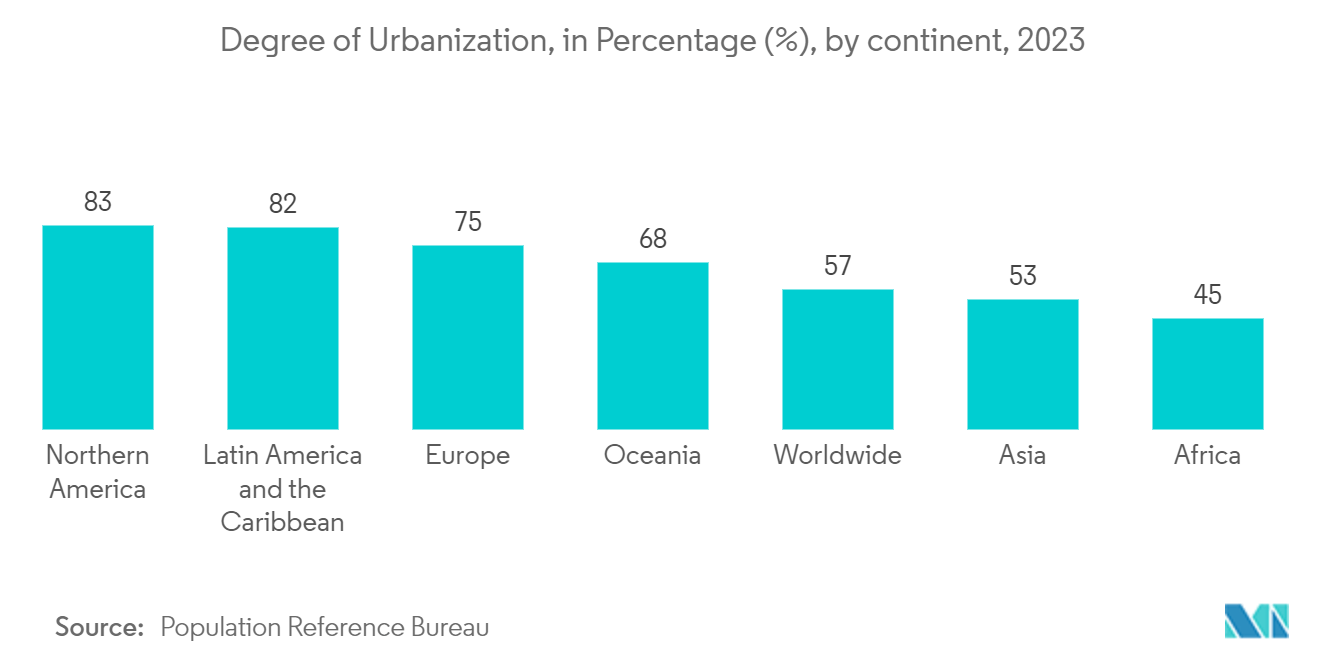
North America is Expected to hold a Significant Market Share
- North America stands as a prominent market for ball valves, boasting substantial demand across diverse industries such as oil and gas, electricity, food and packaging, and chemicals. Both the United States and Canada exhibit immense demand, further fueled by the swift integration of industrial automation. The projected trend is expected to stimulate the market demand for ball valves in the region.
- North American area is witnessing a growing requirement for intelligent ball valves. Prominent regional industries are transitioning towards ball valves that incorporate processors and networking capabilities to complement advanced monitoring technology, which is coordinated through a central control station. The increased adoption of automation in process industries further reinforces this demand trend.
- The United States assumes a pivotal role in augmenting regional demand in contrast to Canada. The nation experiences a growing demand across nearly all end-user sectors, particularly in oil and gas, refining, and power generation. Higher energy consumption is the primary factor behind the higher demand across these sectors. For instance, according to EIA, total immediate energy consumption in the United States in 2022 was about 102.92 quadrillions Btu, of which petroleum consumption was about 31 percent.
- Furthermore, higher demand for oil & gas and other petroleum products also drives oil producers to increase their production and explore new oil extraction sites, which are expected to help the studied market grow further. For instance, in November 2022, the Canadian Association of Energy Contractors (CAOEC) announced that in 2023, it expects about 6,409 wells to be drilled in Canada, an approximately 15 percent increase from 2022.
- It is expected that new water treatment facilities will likely be set up in the region to feed the demand for ball valves as a result of an anticipated increase in regional population and increased water consumption across different sectors. A notable example is the recent announcement by New York State officials in September 2022, wherein they allocated over USD 232 million for water and sewer infrastructure projects in seven municipalities. The New York State Environmental Facilities Corporation granted funds and offered low-cost financing packages to facilitate water infrastructure initiatives with a cumulative expenditure exceeding USD 763 million. These investments in establishing treatment plants will inevitably augment the need for ball valves.
- Ball valves are utilized to regulate pressure and flow. Their leak-proof nature is a notable attribute that renders them highly advantageous, particularly in the chemical industry involving liquids. In July of 2022, BASF declared its final investment decision on a project worth USD 780 million, aimed at doubling the production capacity of its chemical manufacturing complex in Ascension Parish, Louisiana. The expansion project, which spans over seven years and represents a combined capital investment of over USD 1 billion, will enable the company In order to meet the growing demand for its products in a variety of sectors, such as construction, appliances, road haulage, and automobiles throughout North America.
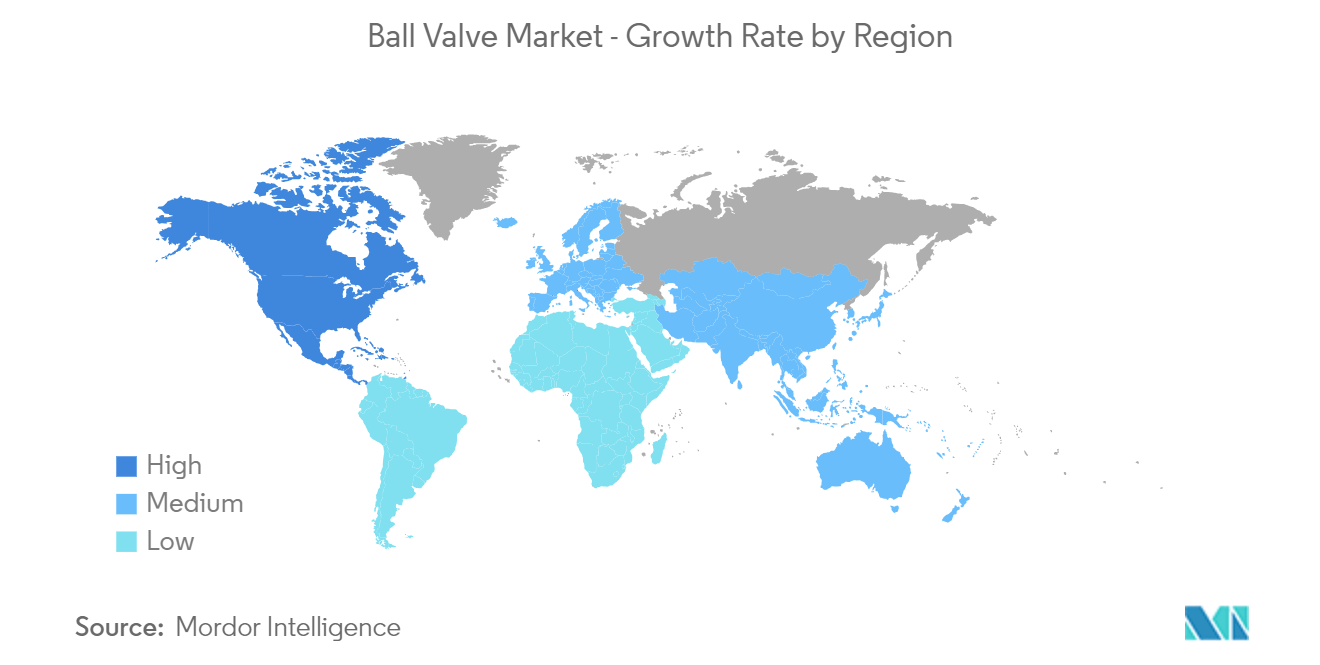
Ball Valve Industry Overview
The ball valve market is fragmented and consists of several players, with no group currently holding a major share in the market. The companies are engaging in mergers and acquisitions to increase their expertise in the product. The market is viewed as a lucrative investment opportunity due to its wide consumer base. Some key market players include Flowserve Corporation, Alfa Laval, Crane Co., Honeywell International Inc., etc.
- November 2023 - Alfa Laval expands its valve portfolio with two new additions. The new valves, Unique Mixproof Process, and Unique Mixproof CIP enhance product safety by ensuring media is always separated. Their fully balanced design also enables risk-free handling at high pressures.
Ball Valve Market Leaders
-
ALFA LAVAL
-
Crane Co.
-
Flowserve Corporation
-
Emerson Electric Co.
-
HONEYWELL INTERNATIONAL INC.
- *Disclaimer: Major Players sorted in no particular order
Ball Valve Market News
- November 2024 - Heap and Partners has designed and manufactured 12 of its Phase trunnion ball valves for a Serica Energy maintenance campaign this year at the Bruce Field facilities in the UK North Sea. The 16-inch valves were the largest produced by the company, weighing under four metric tons.
- December 2023 - Allied Valve Inc. partnered with REXA as the exclusive sales and service partner for the states of Indiana, Illinois, Missouri, Wisconsin, Minnesota, Iowa, Nebraska, North Dakota, South Dakota, and Kansas. REXA is one of the leading manufacturers of linear and rotary actuators and damper drives for the oil and gas, power, metals, mining, and pulp and paper industries.
- January 2024 - Total Valve Systems announced its partnership with Crane ChemPharma & Energy, a business of Crane Company, to distribute and be an authorized service center for various valve products.
Ball Valve Industry Segmentation
The ball valve is a spherical closure device that controls the flow and pressure of liquids and gases within a system. These quarter-turn valves use a hollow, perforated, and pivoting ball to control flow through it.
The ball valve market is segmented by material (cast iron, steel, alloy-based), end-user industry (oil and gas, chemicals, water and wastewater, power, food and beverage, pharmaceuticals), and geography (North America, Europe, Asia Pacific, Latin America, and the Middle East and Africa).
The market sizes and predictions are provided in terms of value in USD for all the above segments.
| By Material (Qualitative Analysis) | Cast Iron |
| Steel | |
| Alloy Based | |
| Other Materials | |
| By End-User Industry | Oil and Gas |
| Chemicals | |
| Water and Waste Water | |
| Power | |
| Food and Beverage | |
| Pharmaceutical | |
| Other End-User Industries | |
| By Geography*** | North America |
| Europe | |
| Asia | |
| Australia and New Zealand | |
| Latin America | |
| Middle East and Africa |
Ball Valve Market Research FAQs
How big is the Ball Valve Market?
The Ball Valve Market size is expected to reach USD 13.09 billion in 2025 and grow at a CAGR of 3.70% to reach USD 15.69 billion by 2030.
What is the current Ball Valve Market size?
In 2025, the Ball Valve Market size is expected to reach USD 13.09 billion.
Who are the key players in Ball Valve Market?
ALFA LAVAL, Crane Co., Flowserve Corporation, Emerson Electric Co. and HONEYWELL INTERNATIONAL INC. are the major companies operating in the Ball Valve Market.
Which is the fastest growing region in Ball Valve Market?
Asia Pacific is estimated to grow at the highest CAGR over the forecast period (2025-2030).
Which region has the biggest share in Ball Valve Market?
In 2025, the Asia Pacific accounts for the largest market share in Ball Valve Market.
What years does this Ball Valve Market cover, and what was the market size in 2024?
In 2024, the Ball Valve Market size was estimated at USD 12.61 billion. The report covers the Ball Valve Market historical market size for years: 2019, 2020, 2021, 2022, 2023 and 2024. The report also forecasts the Ball Valve Market size for years: 2025, 2026, 2027, 2028, 2029 and 2030.
Our Best Selling Reports
Ball Valve Industry Report
Statistics for the 2025 Ball Valve market share, size and revenue growth rate, created by Mordor Intelligence™ Industry Reports. Ball Valve analysis includes a market forecast outlook for 2025 to 2030 and historical overview. Get a sample of this industry analysis as a free report PDF download.

